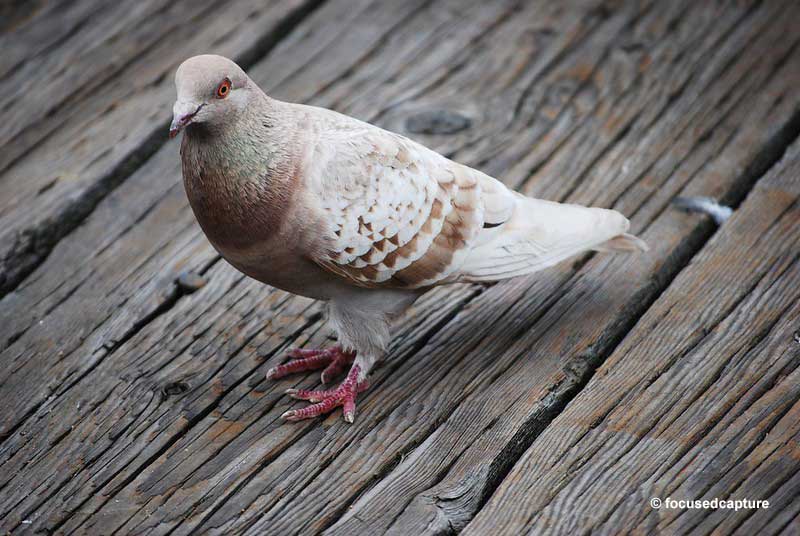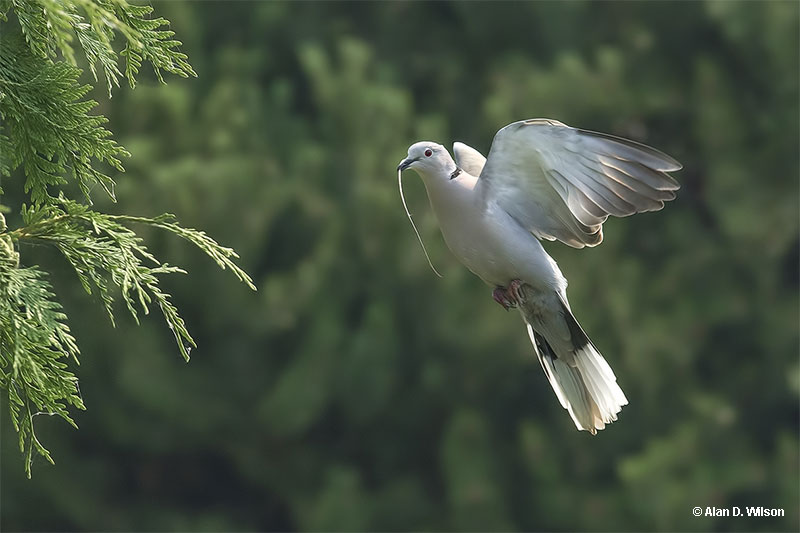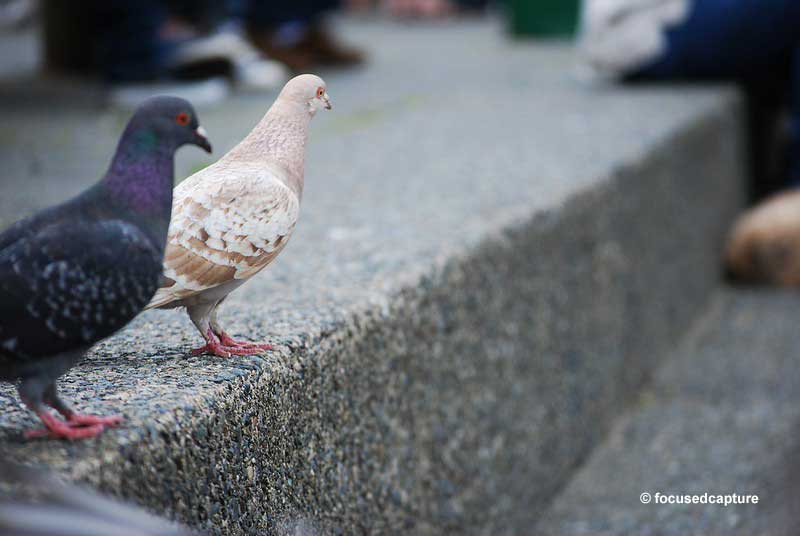
Albino pigeon is easy to misidentify as a dove. And it’s easy to do so – albino pigeons and white doves look similar, but they are very rare in nature.
We sometimes see them flying free, but most come from captivity. Do they even survive in the wild? And can albino pigeons be confused for other birds?
On this page
Albinos or Leucistic Birds?
When we see a bird with white plumage, it’s either an albino bird or one with leucistic plumage. Yes, there are egrets and other waterbirds with naturally occurring white feathers, but these birds are the exception.
See more: Types of doves in the U.S.
The white pigeons (also known as white doves) that fly into the sky after a wedding do not show their natural dark feathers. Since these birds were raised to have white feathers, they are often albino.
In addition to having snow-white feathers, we can recognize them as being albino by taking a close look at their eyes and bare skin.
Like other albino animals, albino pigeons have reddish or pink eyes, reddish legs, and pink skin.
However, if one of those flying pigeons looks off-white or has a few gray feathers, it’s not an albino pigeon. Such birds have leucistic plumage. The difference between the two is that albino birds are unable to make pigments, while leucistic birds have a mutation that affects how feathers are pigmented.
This is why albino pigeons are completely white. They simply can’t have any pigment in their plumage, eyes, nor skin. Leucistic pigeons, on the other hand, don’t look pure white because they actually produce some type of pigment.
Chances of Survival
Albino animals are rare in the wild, pigeons included. Since it’s a recessive trait, most baby animals are just born with typical colors for their species. In the case of pigeons, those colors are shades of gray with bits of white and black.
These colors help them blend into the dark seaside and mountain cliffs in Eurasia, where they evolved. Apparently, those dark colors also work in cities, at least much better than entirely white plumage.
Whether an animal is a pigeon, deer, or something else, the problem with white plumage is that it makes the animal completely obvious.
This is a problem for animals that avoid predators by blending into their surroundings. It’s especially bad for pigeons and other birds that flock together because one of the main ways they avoid predators is by looking like each other when they fly together.
The idea is that if all the birds look the same and fly close together, it’s much harder to pick out just one bird. However, albino pigeons might as well have a bullseye on them because they stand out like a sore thumb.
They don’t survive very well because they end up getting caught much more easily by Peregrine Falcons and other predators.
Do Albino Pigeons Look Similar To Doves?
Albino pigeons are pretty easy to recognize. In most places, no other wild, pigeon-sized bird has entirely white plumage. If you see a white pigeon in flight, it’s a fair bet that you are seeing an albino pigeon.
The only exceptions are a pair of non-pigeon birds that live in Costa Rica and some other parts of Central America. If you go birding there and see an all-white bird with a short tail flying over rainforest, congratulate yourself for seeing a rare Snowy Cotinga or endangered Yellow-billed Cotinga!
If you are watching birds in southern Asia, northern Australia, and Providence Island in the Bahamas, you might also see a wild pigeon with mostly white plumage. In those places, the Pied Imperial Pigeon frequents coastal habitats. This bird is a striking white pigeon, but it also has some black in its wings and tail.

Eurasian Collared-Doves do look fairly similar to albino or leucistic pigeons. However, as their name hints, they have a ‘collar’ around their necks.
In most places, there is only one dove that can be confused with an albino pigeon: the Eurasian Collared-Dove. This species is very pale and in certain lighting, might appear to be entirely white. However, with a close look, we can see that it is actually pale gray and brown above, has a black mark on its neck, and some black on its tail.
Fun Facts
- Albino birds have red eyes and pink skin because they lack melanin. The reddish we see is the color of their blood vessels.
- Leucistic birds can have entirely off-white plumage but usually have some white feathers mixed with gray and regularly colored plumage.
- Albino pigeons and other albino animals often have vision and other health problems associated with recessive genes.
- Birds that have natural white plumage may have white feathers to protect them from UV rays or for social flocking purposes.
- Albino pigeons can’t usually fly as well as pigeons with dark feathers. Their white feathers are not as durable as darker plumes.
- When albino pigeons molt their feathers, their feathers still come out completely white.
- Albino pigeons and other albino birds often have trouble finding a mate. They just don’t have the colors and patterns that female birds look for when choosing a mate.
- Albinism is rare but not uncommon. When it comes to birds, pigeons are a good example, but there are many other species susceptible to this – crows, woodpeckers, hummingbirds, and even peacocks.
Frequently Asked Questions
How rare is an albino pigeon?
In the wild, an albino pigeon is extremely rare. However, many are bred in captivity.
Is it rare to see a white pigeon?
Yes, it is rare to see a white pigeon. However, since many are released into the wild, it occasionally happens.
What is the difference between an albino pigeon and a white dove?
Usually, there is no real difference between an albino pigeon and a white dove. Since pigeons are also known as “Rock Doves,” they are usually two terms for the same type of bird. However, if the white dove has a dark eye, it is not an albino but probably a leucistic dove. Some pale Ringed Turtle-Doves are also known as “White Doves”.
Do albino pigeons live long?
No, albino pigeons don’t live long, at least in the wild. They are usually caught by a predator in the first year of their life. However, in captivity, albino pigeons can live for several years.


